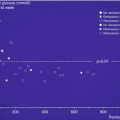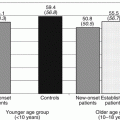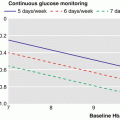in addition to a correction insulin  . If BG is already in target range or a meal is not expected, the respective portion of the bolus calculation is to be ignored. Furthermore, to prevent insulin stacking, one must also consider insulin that is still active from a previous bolus (insulin on board or IOB). Personalized insulin kinetics (insulin duration of action) must be assessed in order to correctly calculate IOB [16]. Another important variable that is frequently underestimated is the current physiological state (PS) of the individual. For example, in case of increased or decreased insulin sensitivity (IS) due to physical activity or intermittent disease, respectively, PS may be >1 (decreased IS) or <1 (increased IS). Therefore the complete equation [12] is
. If BG is already in target range or a meal is not expected, the respective portion of the bolus calculation is to be ignored. Furthermore, to prevent insulin stacking, one must also consider insulin that is still active from a previous bolus (insulin on board or IOB). Personalized insulin kinetics (insulin duration of action) must be assessed in order to correctly calculate IOB [16]. Another important variable that is frequently underestimated is the current physiological state (PS) of the individual. For example, in case of increased or decreased insulin sensitivity (IS) due to physical activity or intermittent disease, respectively, PS may be >1 (decreased IS) or <1 (increased IS). Therefore the complete equation [12] is
As mentioned earlier the parameters of this equation may vary during the day. This equation is therefore too complex and time consuming to be used on a daily basis. Bolus calculators have therefore been created in order to dramatically simplify the bolus estimate, although they still do not take into consideration certain potentially useful parameters (Table 15.1) [17]. The use of mealtime insulin bolus calculators in both MDI and pump therapy has been shown to assist insulin dose calculations and potentially improve postprandial glycemia [18–20]. ISPAD and ISPED guidelines recommend the use of bolus calculators [1, 21].
Table 15.1
Bolus calculators: what is and what should be included in the equation
Target BG |
Glycemic index |
Current BG |
Fat, protein, and fiber content |
ICR |
Gastric emptying rate |
IOB |
Insulin absorption rate (injection site) |
CF |
Physiological state |
|
Circadian rhythm |
|
Time elapsed since previous meal (second-meal phenomenon) |
The aforementioned calculations are made assuming that CHO is the nutrient with greatest impact on postprandial BG excursions and that protein and fat involvement is minor and sufficiently covered by the basal insulin. However there is increasing evidence that the impact of fat and protein should be considered when determining the bolus insulin dose and mode of delivery [
22–
25]. There is still no universally accepted algorithm regarding bolus calculations including carbohydrates, fats, and protein. It is also debatable whether most patients are able (considering both motivation and time availability) to perform these nutritional evaluations [
26].
15.3 Pump Bolus Calculators
All commercially available insulin pump possess built-in automated BCs. Depending on the manufacturer, the BC algorithms differ slightly with respect to the way they handle IOB and correction of hyperglycemia. However, healthcare professionals should be aware of these manufacturer-specific differences to be able to set the pump correctly [
27]. Unless the IOB is accurately determined, and the target BG ranges accurately set, a BC may tend to under- or overtreat postprandial hyperglycemia. Some BCs correct to the midpoint of the preprogrammed BG target range, whereas other systems correct to the upper limits of the target range. Although BCs integrated in pumps have been on the market for several years, there are still very few studies on their effectiveness [
28].
A cross-sectional study of 88 adult T1D insulin pump users with a mean HbA1c of 6.8 % found that patients who used the insulin pump BC for ≥ 50 % of bolus calculations had HbA1c, mean BG, and mean BG standard deviation that were significantly lower than patients who used the BC less (0.6 %, 25.45 mg/dl, and 9.1 mg/dl, respectively) [
29].
In a prospective study of 30 patients who switched from an insulin pump without a BC to a pump with a BC and used the BC for 80 % of bolus calculations, HbA1c levels decreased significantly by 0.2 % points after the switch [
30]. The study further reported that postprandial BG values improved significantly. This observation has been confirmed by other small studies in CSII-treated patients [
31,
32].
On the contrary, a 12-month randomized, controlled pediatric study (
N = 45) was not able to demonstrate any additional effect of BC use with regard to HbA1c, postprandial BG values, or other study outcomes [
19].
Recent randomized controlled trials and meta-analyses have shown that the use of a BC improved glycemic control in MDI patients and children undergoing CSII treatment [
33–
35].
15.4 BC Settings
The effectiveness of a BC depends primarily on the adequacy of the settings. Therefore, BC settings must be verified routinely with a skilled healthcare team in order to make adjustments when necessary. The ICR, CF, and BG target range represent the least variable settings. If CF or ICR are set too low or too high, the patient will probably suffer from recurrent low and high BGs, respectively. The BC BG target should be set according to the manufacturer-specific algorithms for correction (midpoint vs upper range) to the glycemic goals of the individual patient. DIA setting accuracy is also essential, because a DIA set too short leads to insulin stacking, and if DIA is set too long, it may lead to a compensatory increase in basal rate [
12,
15,
16].
The user must also be precise in the assessment of CHO contents, the impact of daily events on PS, and correct BG sampling techniques [
36].
If the requirements mentioned above are not met, the BC output is likely to be false, and as a consequence, the patient might lose confidence in the device and stop using it. One should not expect any effect from a BC, if it is not in use. Therefore, to get the greatest possible benefit from BC use, it is important to train patients and their potential caretakers in general diabetes management as well as in the use of the device. To further stimulate treatment adherence, BC use should be addressed, and BC settings should be evaluated routinely during consultations to emphasize their importance and make continuous use of the device meaningful to the patient.
15.5 Bolus Types
Current insulin pumps are capable of delivering meal bolus insulin in three ways (names may vary according to manufacturer): standard or rapid bolus (SB), where the insulin is delivered immediately (similarly to MDI); extended or square wave bolus, where the insulin delivery is spread over a longer time period; and combination or dual wave bolus, where a percentage of the insulin is delivered as a rapid bolus, and the remainder is delivered as an extended bolus (EB) (Fig.
15.1). Theoretically, different types of prandial insulin bolus pumps should enable better coverage of prandial insulin requirements in view of huge variability in which meals can be served. To date there is very little data in literature comparing the different methods of meal bolus insulin delivery and the frequency of their use [
37,
38]. There is no current evidence-based guideline available to assist clinicians, patients, and families wishing to program an extended or combination insulin bolus. However, there is general consensus on the timing of insulin administration which, for rapid-acting insulin, should be about 15 min prior to consuming a meal [
1,
39].
Despite current recommendations to use extended and combination boluses for meals high in fat and protein or with low glycemic index, in routine clinical practice most patients and families mainly use the standard bolus to deliver the mealtime insulin dose [
40]. There are very few studies assessing the efficacy of extended insulin boluses. One particular study suggests to count protein and fat (fat-protein units or FPUs) for calculating insulin requirements when using a pump. One FPU equals 100 kcal of fat or protein and requires the same amount of insulin (as an extended bolus) as 10 g of carbohydrates [
24]. As summarized by Heinemann et al., there is not enough research to date suggesting that other bolus types (extended/combined) allow better postprandial glucose levels with respect to a standard bolus [
37,
38,
41]. In summary, the studies published so far about the advantages of different bolus types have only proved that the evidence for the use of different types of boluses is limited, mainly due to shortcomings in the studies themselves (e.g., small sample size, only certain limited age groups were involved, preprandial BG was not always adequately controlled during the study period). Only a clinical study with a significant sample size can prove if the use of different boluses is advantageous.
15.6 Temporary Basal Rates
Another advantage of using an insulin pump is the ability to use temporary basal rates. Very few studies have been performed on this topic as well. A study by Wilkinson et al. has shown that the more frequent use of temporary basal rates was a significant factor relating to improvement in HbA1c [
42]. The ability to diminish basal insulin levels during heavy afternoon exercise is easily possible with an insulin pump and provides a great advantage in reducing hypoglycemia during exercise. Ideally, the initial reduction in insulin (50–80 % reduction depending upon the intensity and duration of the activity), lasting until the end of exercise, may need to occur 15–90 mins prior to the exercise [
43]. This is because the current rapid-acting insulin peak after administration is at approximately 90 min. In addition, if the exercise is 1–2 h after bolus, a 15–30-g carbohydrate snack prior to the exercise may help to prevent hypoglycemia. Trial and error (e.g., starting with a 50 % reduction) with frequent BG monitoring (or the use of a CGM) must be used to fine tune and tailor the optimal management for a given individual and a given exercise. Furthermore, some prevent delayed hypoglycemia during the night following days of significant exercise by applying a reduced temporary basal rate during the night (e.g., 20 % basal rate reduction from 9 p.m. to 3 a.m.) [
44–
46].
During illness it also may be necessary to temporarily increase basal insulin doses. With a pump, temporary basal rate increases of 20 % to as high as 50 or 100 % may be used. On the other hand, during infections associated with hypoglycemia (mainly gastroenteritis), a temporary basal reduction (but not elimination) may be advised as well as replacing meals with frequent small volumes of sugary drinks that also contain electrolytes [
47].
 . If BG is already in target range or a meal is not expected, the respective portion of the bolus calculation is to be ignored. Furthermore, to prevent insulin stacking, one must also consider insulin that is still active from a previous bolus (insulin on board or IOB). Personalized insulin kinetics (insulin duration of action) must be assessed in order to correctly calculate IOB [16]. Another important variable that is frequently underestimated is the current physiological state (PS) of the individual. For example, in case of increased or decreased insulin sensitivity (IS) due to physical activity or intermittent disease, respectively, PS may be >1 (decreased IS) or <1 (increased IS). Therefore the complete equation [12] is
. If BG is already in target range or a meal is not expected, the respective portion of the bolus calculation is to be ignored. Furthermore, to prevent insulin stacking, one must also consider insulin that is still active from a previous bolus (insulin on board or IOB). Personalized insulin kinetics (insulin duration of action) must be assessed in order to correctly calculate IOB [16]. Another important variable that is frequently underestimated is the current physiological state (PS) of the individual. For example, in case of increased or decreased insulin sensitivity (IS) due to physical activity or intermittent disease, respectively, PS may be >1 (decreased IS) or <1 (increased IS). Therefore the complete equation [12] is![$$ \mathrm{Bolus}\ \mathrm{insulin}=\left[\left(\frac{\mathrm{CHO}}{\mathrm{ICR}}+\frac{\mathrm{current}\ \mathrm{B}\mathrm{G}-\mathrm{target}\ \mathrm{B}\mathrm{G}}{\mathrm{CF}}\right)\times \mathrm{P}\mathrm{S}\right]-\mathrm{I}\mathrm{O}\mathrm{B} $$](http://oncohemakey.com/wp-content/uploads/2017/11/A337733_1_En_15_Chapter_Equa.gif)








